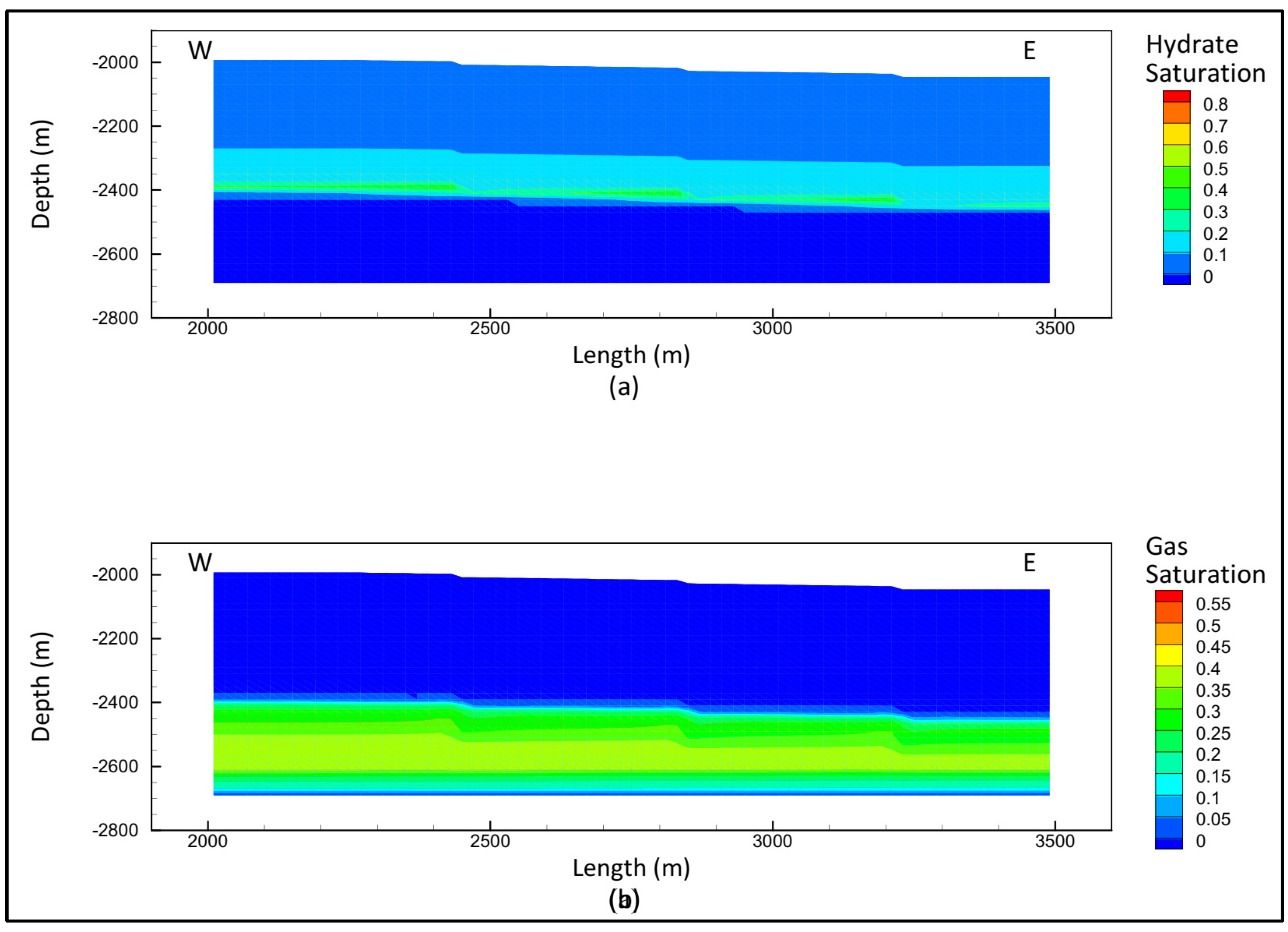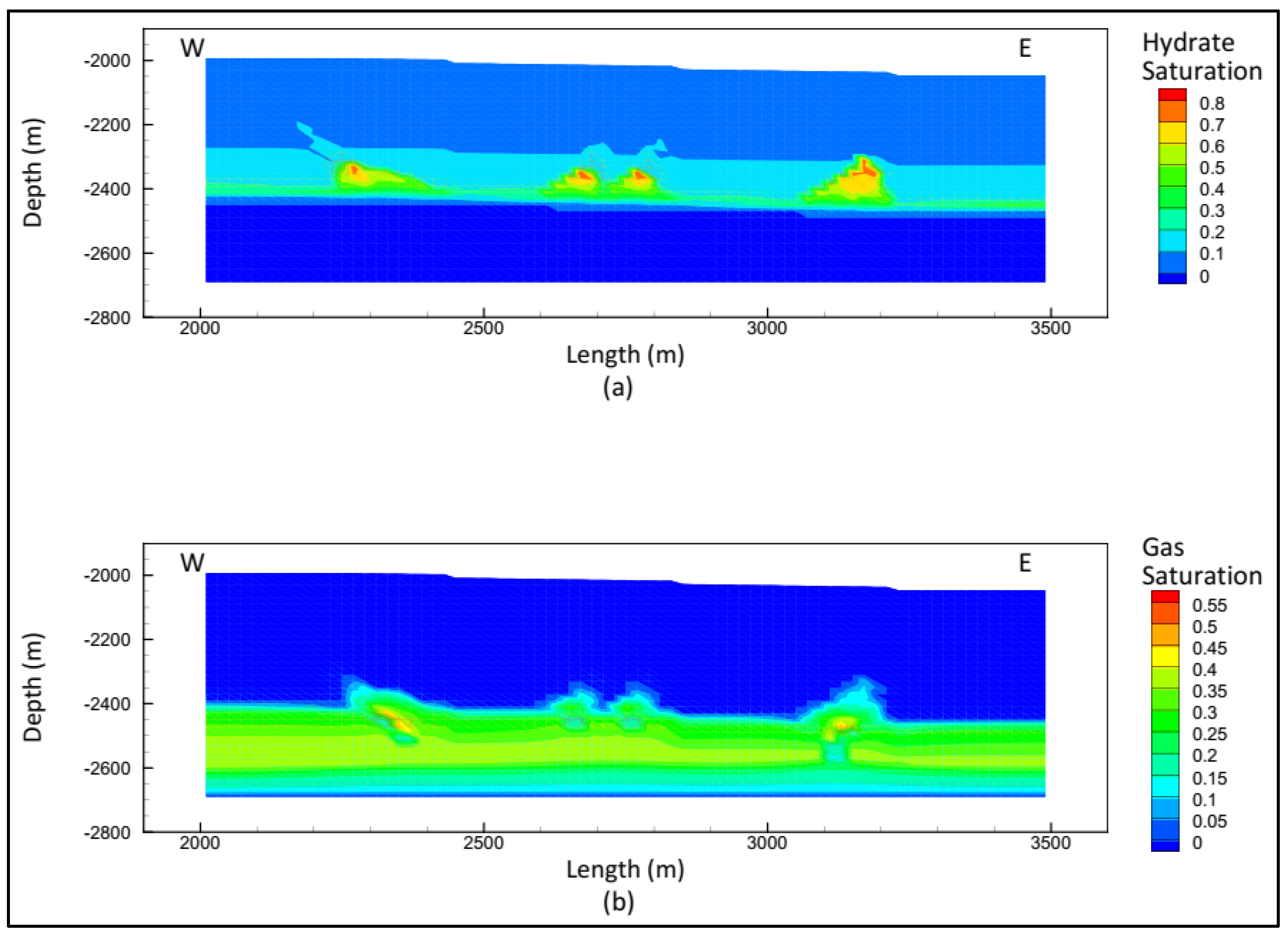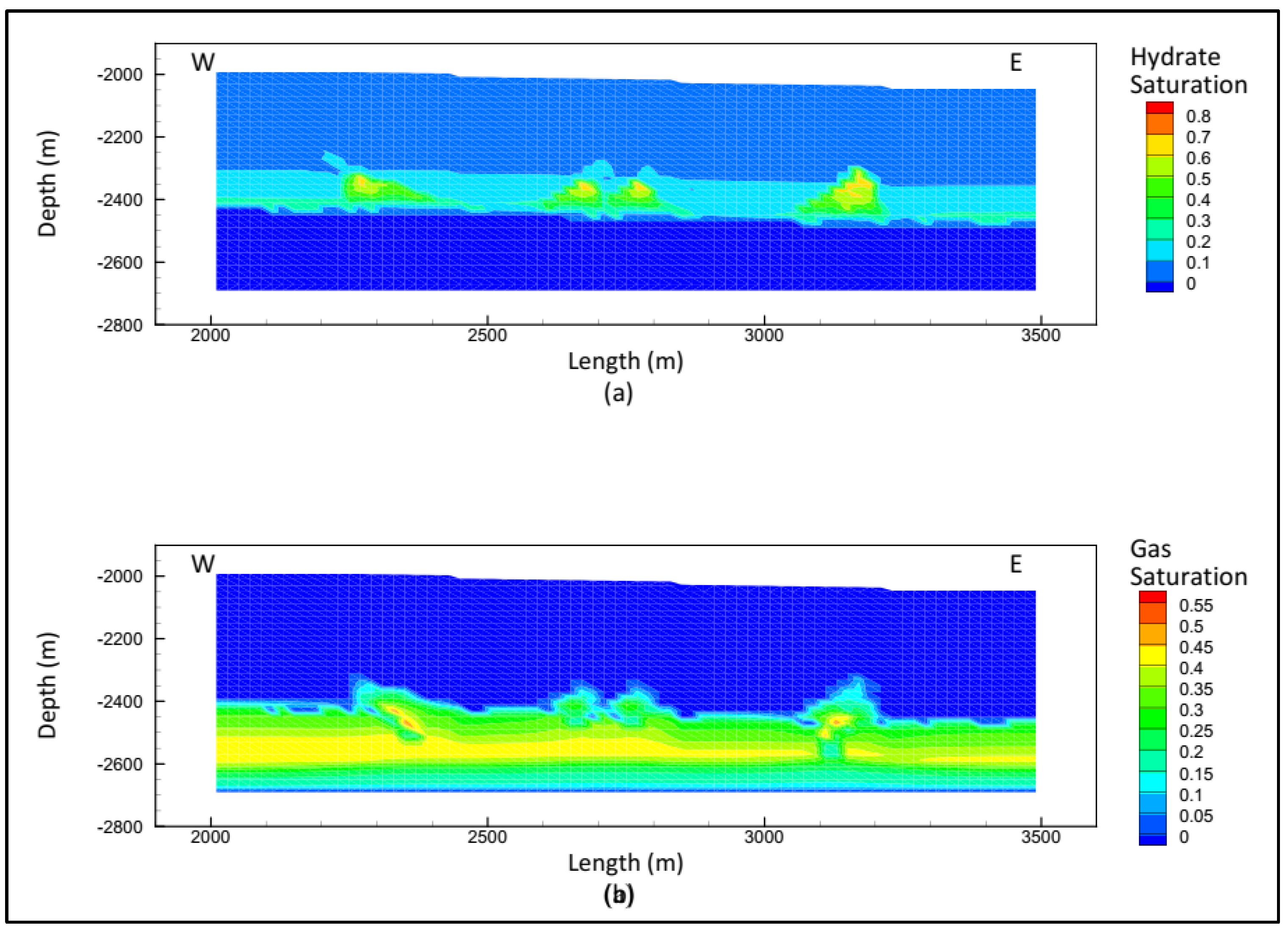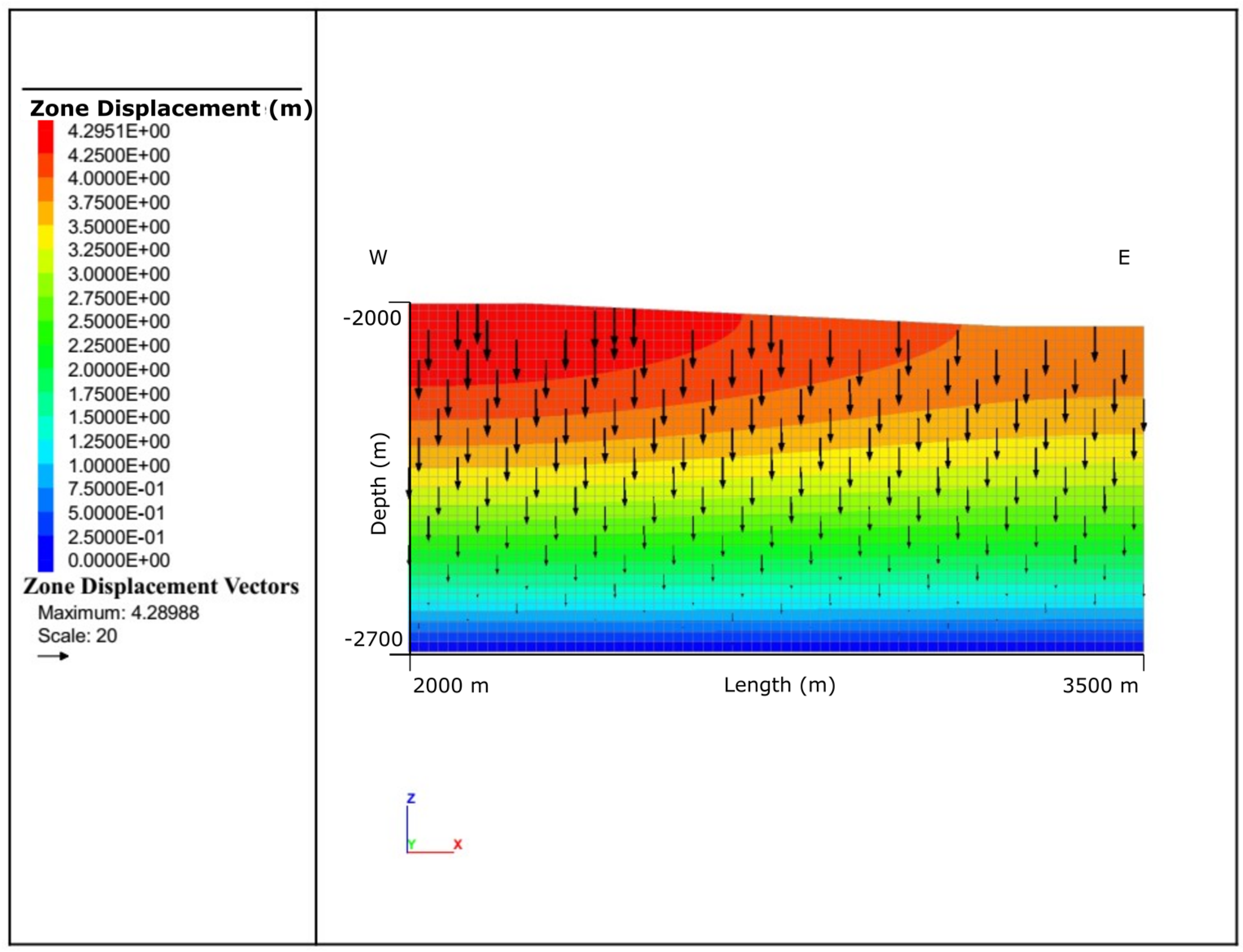Gas Hydrates Reserve Characterization Using Thermo-Hydro-Mechanical Numerical Simulation: A Case Study of Green Canyon 955, Gulf of Mexico
Abstract
:1. Introduction
2. Methodology
- Reservoir characterization of the prolific hydrate-bearing region of the Green Canyon 955 site between two wells, GC955-Q and GC955-H.
- Warming of seafloor temperature by 1 °C over the next 100 years, mimicking a rise in seawater and bottom water temperature due to climate change.
- Production of methane gas from the hydrate reserve using a horizontal well between the two previously drilled wells at the hydrate stability zone.
3. Results
3.1. Reservoir Characterization of Hydrate Formation
3.2. Dissociation Due to Warming of the Seafloor
3.3. Dissociation Due to Production of Methane Gas
4. Discussion
5. Conclusions
Author Contributions
Funding
Data Availability Statement
Acknowledgments
Conflicts of Interest
References
- Sloan, E.D. Physical/chemical properties of gas hydrates and application to world margin stability and climatic change. Geol. Soc. Lond. Spec. Publ. 1998, 137, 31–50. [Google Scholar] [CrossRef]
- Sloan, E.D.; Koh, C. Clathrate Hydrates of Natural Gases; CRC Press: Boca Raton, FL, USA, 2007. [Google Scholar]
- Kvenvolden, K. A primer on the geological occurrence of gas hydrate. Geol. Soc. Lond. Spec. Publ. 1998, 137, 9–30. [Google Scholar] [CrossRef]
- Makogon, Y.F. Natural gas hydrates–A promising source of energy. J. Nat. Gas Sci. Eng. 2010, 2, 49–59. [Google Scholar] [CrossRef]
- Kim, H.; Bishnoi, P.; Heidemann, R.; Rizvi, S. Kinetics of methane hydrate decomposition. Chem. Eng. Sci. 1987, 42, 1645–1653. [Google Scholar] [CrossRef]
- Selim, M.S.; Sloan, E.D. Heat and mass transfer during the dissociation of hydrates in porous media. AIChE J. 1989, 35, 1049–1052. [Google Scholar] [CrossRef]
- Clarke, M.; Bishnoi, P.R. Determination of the activation energy and intrinsic rate constant of methane gas hydrate decomposition. Can. J. Chem. Eng. 2001, 79, 143–147. [Google Scholar] [CrossRef]
- Yamamoto, K. Overview and introduction: Pressure core-sampling and analyses in the 2012–2013 MH21 offshore test of gas production from methane hydrates in the eastern Nankai Trough. Mar. Pet. Geol. 2015, 66, 296–309. [Google Scholar] [CrossRef]
- Sloan, E.D. Fundamental principles and applications of natural gas hydrates. Nature 2003, 426, 353–363. [Google Scholar] [CrossRef]
- BSEE. Bureau of Safety and Environmental Enforcement Database. The Offshore Infrastructure Dashboard. 2023. Available online: https://www.data.bsee.gov/ (accessed on 27 March 2023).
- Murawski, S.A.; Hollander, D.J.; Gilbert, S.; Gracia, A. Deepwater oil and gas production in the Gulf of Mexico and related global trends. In Scenarios and Responses to Future Deep Oil Spills; Springer: Berlin/Heidelberg, Germany, 2020; pp. 16–32. [Google Scholar]
- Boswell, R.; Collett, T.S.; Frye, M.; Shedd, W.; McConnell, D.R.; Shelander, D. Subsurface gas hydrates in the northern Gulf of Mexico. Mar. Pet. Geol. 2012, 34, 4–30. [Google Scholar] [CrossRef]
- Brooks, J.; Kennicutt, M.; Fay, R.; McDonald, T.; Sassen, R. Thermogenic gas hydrates in the Gulf of Mexico. Science 1984, 225, 409–411. [Google Scholar] [CrossRef]
- Fang, Y.; Flemings, P.B.; Daigle, H.; Phillips, S.C.; Germaine, J.T. Insight of in-situ porosity and compressibility of the GC 955 Gulf of Mexico hydrate reservoir. In E3S Web of Conferences 2020; EDP Sciences: Les Ulis, France, 2020; Volume 2005, p. 11005. [Google Scholar]
- Hillman, J.I.; Cook, A.E.; Daigle, H.; Nole, M.; Malinverno, A.; Meazell, K.; Flemings, P.B. Gas hydrate reservoirs and gas migration mechanisms in the Terrebonne Basin, Gulf of Mexico. Mar. Pet. Geol. 2017, 86, 1357–1373. [Google Scholar] [CrossRef]
- Daigle, H.; Cook, A.; Malinverno, A. Permeability and porosity of hydrate-bearing sediments in the northern Gulf of Mexico. Mar. Pet. Geol. 2015, 68, 551–564. [Google Scholar] [CrossRef] [Green Version]
- Santra, M.; Flemings, P.B.; Heidari, M.; You, K. Occurrence of high-saturation gas hydrate in a fault-compartmentalized anticline and the role of seal, Green Canyon, Abyssal Northern Gulf of Mexico. AAPG Bull. 2021, 106, 981–1003. [Google Scholar] [CrossRef]
- You, K.; Flemings, P. Methane Hydrate Formation and Evolution During Sedimentation. J. Geophys. Res. Solid Earth 2021, 126, e2020JB021235. [Google Scholar] [CrossRef]
- You, K.; Flemings, P.B.; Malinverno, A.; Collett, T.; Darnell, K. Mechanisms of Methane Hydrate Formation in Geological Systems. Rev. Geophys. 2019, 57, 1146–1196. [Google Scholar] [CrossRef]
- Flemings, P.; Boswell, R.; Collett, T.S.; Cook, A.; Divins, D.; Frye, M.; Guerin, G.; Goldberg, D.; Malinverno, A.; Meazell, K. GOM2: Prospecting, Drilling and Sampling Coarse-Grained Hydrate Reservoirs in the Deepwater Gulf of Mexico; National Energy Technology Laboratory (NETL): Pittsburgh, PA, USA; Morgantown, WV, USA, 2017. [Google Scholar]
- Ruppel, C.; Boswell, R.; Jones, E. Scientific results from Gulf of Mexico gas hydrates Joint Industry Project Leg 1 drilling: Introduction and overview. Mar. Pet. Geol. 2008, 25, 819–829. [Google Scholar] [CrossRef]
- Guerin, G.; Cook, A.; Mrozewski, S.; Collett, T.; Boswell, R. Gulf of Mexico gas hydrate joint industry project leg ii Green Canyon 955 LWD operations and results. Mar. Pet. Geol. 2010, 34, 41–61. [Google Scholar]
- Boswell, R.; Frye, M.; Shelander, D.; Shedd, W.; McConnell, D.R.; Cook, A. Architecture of gas-hydrate-bearing sands from Walker Ridge 313, Green canyon 955, and Alaminos canyon 21: Northern deepwater Gulf of Mexico. Mar. Pet. Geol. 2012, 34, 134–149. [Google Scholar] [CrossRef]
- Haines, S.S.; Hart, P.E.; Collett, T.S.; Shedd, W.; Frye, M.; Weimer, P.; Boswell, R. High-resolution seismic characterization of the gas and gas hydrate system at Green Canyon 955, Gulf of Mexico, USA. Mar. Pet. Geol. 2017, 82, 220–237. [Google Scholar] [CrossRef] [Green Version]
- Wang, J.; Jaiswal, P.; Haines, S.S.; Hart, P.E.; Wu, S. Gas hydrate quantification using full-waveform inversion of sparse ocean-bottom seismic data: A case study from Green Canyon Block 955, Gulf of Mexico. Geophysics 2018, 83, B167–B181. [Google Scholar] [CrossRef]
- Lee, M.W.; Collett, T.S. Pore- and fracture-filling gas hydrate reservoirs in the Gulf of Mexico Gas Hydrate Joint Industry Project Leg II Green Canyon 955 H well. Mar. Pet. Geol. 2012, 34, 62–71. [Google Scholar] [CrossRef]
- Cook, A.E.; Anderson, B.I.; Rasmus, J.; Sun, K.; Li, Q.; Collett, T.S.; Goldberg, D.S. Electrical anisotropy of gas hydrate-bearing sand reservoirs in the Gulf of Mexico. Mar. Pet. Geol. 2012, 34, 72–84. [Google Scholar] [CrossRef] [Green Version]
- Meazell, P.K.; Flemings, P.B.; Santra, M.; Johnson, J.E. Sedimentology and stratigraphy of a deep-water gas hydrate reservoir in the northern Gulf of Mexico. AAPG Bull. 2020, 104, 1945–1969. [Google Scholar] [CrossRef]
- Phillips, S.C.; Flemings, P.B.; Holland, M.E.; Schultheiss, P.J.; Waite, W.F.; Jang, J.; Petrou, E.G.; Hammon, H. High concentration methane hydrate in a silt reservoir from the deep-water Gulf of Mexico. AAPG Bull. 2020, 104, 1971–1995. [Google Scholar] [CrossRef]
- Liu, J.; Haeckel, M.; Rutqvist, J.; Shuhong, W.; Wen, Y. The mechanism of methane gas migration through the gas hydrate stability zone; insights from numerical simulations. J. Geophys. Res. Solid Earth 2019, 124, 4399. [Google Scholar] [CrossRef] [Green Version]
- Liu, X.; Flemings, P.B. Passing gas through the hydrate stability zone at southern Hydrate Ridge, offshore Oregon. Earth Planet. Sci. Lett. 2006, 241, 211–226. [Google Scholar] [CrossRef]
- Riedel, M.; Tréhu, A.M.; Spence, G.D. Characterizing the thermal regime of cold vents at the northern Cascadia margin from bottom-simulating reflector distributions, heat-probe measurements and borehole temperature data. Mar. Geophys. Res. 2010, 31, 1–16. [Google Scholar] [CrossRef]
- Hyndman, R.D.; Spence, G.D. A seismic study of methane hydrate marine bottom simulating reflectors. J. Geophys. Res. Solid Earth 1992, 97, 6683–6698. [Google Scholar] [CrossRef]
- Milkov, A.; Sassen, R. Estimate of gas hydrate resource, northwestern Gulf of Mexico continental slope. Mar. Geol. 2001, 179, 71–83. [Google Scholar] [CrossRef]
- Sassen, R.; Macdonald, I.R. Hydrocarbons of experimental and natural gas hydrates, Gulf of Mexico continental slope. Org. Geochem. 1997, 26, 289–293. [Google Scholar] [CrossRef]
- Burwicz, E.; Reichel, T.; Pinero, E.; Hensen, C.; Wallmann, K.; Haeckel, M. Gas Hydrate Dynamics at the Green Canyon Site, Gulf of Mexico-Recovery Prospects Based on New 3-D Modeling Study; China Geological Survey: Beijing, China, 2014. [Google Scholar]
- Burwicz, E.; Reichel, T.; Wallmann, K.; Rottke, W.; Haeckel, M.; Hensen, C. 3-D basin-scale reconstruction of natural gas hydrate system of the Green Canyon, Gulf of Mexico. Geochem. Geophys. Geosyst. 2017, 18, 1959–1985. [Google Scholar] [CrossRef] [Green Version]
- Dhakal, S.; Gupta, I. Thermogenic Gas Hydrates Formation in Offshore Environments-Results from Numerical Simulations. In Proceedings of the Offshore Technology Conference, Houston, TX, USA, 30 April–3 May 2018. [Google Scholar]
- Milkov, A.; Sassen, R. Thickness of the gas hydrate stability zone, Gulf of Mexico continental slope. Mar. Pet. Geol. 2000, 17, 981–991. [Google Scholar] [CrossRef]
- You, K.; Summa, L.; Flemings, P.; Santra, M.; Fang, Y. Three-Dimensional Free Gas Flow Focuses Basin-Wide Microbial Methane to Concentrated Methane Hydrate Reservoirs in Geological System. J. Geophys. Res. Solid Earth 2021, 126, e2021JB022793. [Google Scholar] [CrossRef]
- Mao, P.; Sun, J.; Ning, F.; Chen, L.; Wan, Y.; Hu, G.; Wu, N. Numerical simulation on gas production from inclined layered methane hydrate reservoirs in the Nankai Trough: A case study. Energy Rep. 2021, 7, 8608–8623. [Google Scholar] [CrossRef]
- Yadav, R.; Gupta, A.K.; Das, M.K.; Panigrahi, P.K. Investigations on a controlled microwave heating technique for efficient depressurization in methane hydrate reservoirs. Energy Rep. 2022, 8, 7825–7839. [Google Scholar] [CrossRef]
- Wu, H.; Zhang, X.; Yang, Z.; Liu, D. Numerical simulation on depressurization extraction of natural gas hydrate based on a coupled thermal–hydraulic–chemical model. Energy Rep. 2022, 8, 269–278. [Google Scholar] [CrossRef]
- Wei, J.; Yang, L.; Liang, Q.; Liang, J.; Lu, J.; Zhang, W.; Zhang, X.; Lu, X. Geomechanical properties of gas hydrate-bearing sediments in Shenhu Area of the South China Sea. Energy Rep. 2021, 7, 8013–8020. [Google Scholar] [CrossRef]
- Dhakal, S.; Gupta, I. Predictive Modeling of Thermogenic Methane Hydrate Formation and Geobody Distribution–Results from Numerical Simulations. J. Nat. Gas Sci. Eng. 2020, 75, 103154. [Google Scholar] [CrossRef]
- Dhakal, S.; Gupta, I. Simulating gas hydrate formation in the southern hydrate ridge, Cascadia Margin. J. Nat. Gas Sci. Eng. 2021, 88, 103845. [Google Scholar] [CrossRef]
- Dhakal, S.; Gupta, I. Slope instability of submarine sediments due to hydrate dissociation: A case study of Northern Cascadia Margin. Geoenergy Sci. Eng. 2023, 223, 211558. [Google Scholar] [CrossRef]
- Burwicz, E.; Rüpke, L. Thermal State of the Blake Ridge Gas Hydrate Stability Zone (GHSZ)—Insights on Gas Hydrate Dynamics from a New Multi-Phase Numerical Model. Energies 2019, 12, 3403. [Google Scholar] [CrossRef] [Green Version]
- You, K.; Flemings, P.B. Methane hydrate formation in thick sandstones by free gas flow. J. Geophys. Res. Solid Earth 2018, 123, 4582–4600. [Google Scholar] [CrossRef]
- Zhu, H.; Xu, T.; Zhu, Z.; Yuan, Y.; Tian, H. Numerical modeling of methane hydrate accumulation with mixed sources in marine sediments: Case study of Shenhu Area, South China Sea. Mar. Geol. 2020, 423, 106142. [Google Scholar] [CrossRef]
- Keyes, D.E.; McInnes, L.C.; Woodward, C.; Gropp, W.; Myra, E.; Pernice, M.; Bell, J.; Brown, J.; Clo, A.; Connors, J. Multiphysics simulations: Challenges and opportunities. Int. J. High Perform. Comput. Appl. 2013, 27, 4–83. [Google Scholar] [CrossRef] [Green Version]
- Liu, X.; Qu, Z.; Guo, T.; Sun, Y.; Rabiei, M.; Liao, H. A coupled thermo-hydrologic-mechanical (THM) model to study the impact of hydrate phase transition on reservoir damage. Energy 2021, 216, 119222. [Google Scholar] [CrossRef]
- Samala, R.; Chaudhuri, A. Coupled THMC modeling of dissociation induced deformation of gas hydrate bearing media. Comput. Geosci. 2022, 166, 105162. [Google Scholar] [CrossRef]
- Wan, Y.; Wu, N.; Chen, Q.; Li, W.; Hu, G.; Huang, L.; Ouyang, W. Coupled thermal-hydrodynamic-mechanical–chemical numerical simulation for gas production from hydrate-bearing sediments based on hybrid finite volume and finite element method. Comput. Geotech. 2022, 145, 104692. [Google Scholar] [CrossRef]
- Kim, S.; Wee, J.; Peters, K.; Huang, H.-Y.S. Multiphysics coupling in lithium-ion batteries with reconstructed porous microstructures. J. Phys. Chem. C 2018, 122, 5280–5290. [Google Scholar] [CrossRef]
- Zhang, H.; Guo, J.; Lu, J.; Niu, J.; Li, F.; Xu, Y. The comparison between nonlinear and linear preconditioning JFNK method for transient neutronics/thermal-hydraulics coupling problem. Ann. Nucl. Energy 2019, 132, 357–368. [Google Scholar] [CrossRef]
- Moridis, G.J. TOUGH+ HYDRATE v1. 2 User’s Manual: A Code for the Simulation of System Behavior in Hydrate-Bearing Geologic Media; LBL Publications: Berkeley, CA, USA, 2014. [Google Scholar]
- Rutqvist, J.; Moridis, G. Numerical studies on the geomechanical stability of hydrate-bearing sediments. In Proceedings of the Offshore Technology Conference, Houston, TX, USA, 29 April–2 May 2007. [Google Scholar]
- Jaiswal, P. Structural and Stratigraphic Controls on Methane Hydrate Occurrence and Distribution: Gulf of Mexico, Walker Ridge 313 and Green Canyon 955; Oklahoma State University: Stillwater, OK, USA, 2017. [Google Scholar]
- Murphy, B.S. PyKrige: Development of a kriging toolkit for Python. In Proceedings of the AGU Fall Meeting Abstracts, San Francisco, CA, USA, 15–19 December 2004. [Google Scholar]
- Forrest, J.; Marcucci, E.; Scott, P. Geothermal Gradients and Subsurface Temperatures in Northern Gulf of Mexico. GCAGS 2005, 55, 233–248. [Google Scholar]
- Christie, C.H.; Nagihara, S. Geothermal gradients of the northern continental shelf of the Gulf of Mexico. Geosphere 2016, 12, 26–34. [Google Scholar] [CrossRef] [Green Version]
- Fang, Y.; Flemings, P.B.; Daigle, H.; Phillips, S.C.; O’Connell, J. Permeability of methane hydrate-bearing sandy silts in the deep-water Gulf of Mexico (Green Canyon block 955). AAPG Bull. 2021, 106, 1071–1110. [Google Scholar] [CrossRef]
- Riedel, M.; Malinverno, A.; Wang, K.; Goldberg, D.; Guerin, G. Horizontal compressive stress regime on the northern Cascadia margin inferred from borehole breakouts. Geochem. Geophys. Geosyst. 2016, 17, 3529–3545. [Google Scholar] [CrossRef] [Green Version]
- Itasca. FLAC3D (Fast Lagrangian Analysis of Continua in 3 Dimensions) Version 6 User’s Manual; Itasca Consulting Group, Inc.: Minneapolis, MN, USA, 2017. [Google Scholar]
- Reagan, M.T.; Moridis, G.J. Oceanic gas hydrate instability and dissociation under climate change scenarios. Geophys. Res. Lett. 2007, 34. [Google Scholar] [CrossRef]
- Kretschmer, K.; Biastoch, A.; Rüpke, L.; Burwicz, E. Modeling the fate of methane hydrates under global warming. Glob. Biogeochem. Cycles 2015, 29, 610–625. [Google Scholar] [CrossRef]
- Sun, X.; Wang, L.; Luo, H.; Song, Y.; Li, Y. Numerical modeling for the mechanical behavior of marine gas hydrate-bearing sediments during hydrate production by depressurization. J. Pet. Sci. Eng. 2019, 177, 971–982. [Google Scholar] [CrossRef]
- Rutqvist, J.; Tsang, C.-F. TOUGH-FLAC: A numerical simulator for analysis of coupled thermal-hydrologic-mechanical processes in fractured and porous geological media under multi-phase flow conditions. In Proceedings of the TOUGH Symposium, Berkeley, CA, USA, 12–14 May 2003; pp. 12–14. [Google Scholar]
- Sultan, N.; Garziglia, S. Geomechanical constitutive modelling of gas-hydrate-bearing sediments. In Proceedings of the 7th International Conference on Gas Hydrates (ICGH 2011), Edinburgh, UK, 17–21 July 2011. [Google Scholar]
- Masui, A.; Haneda, H.; Ogata, Y.; Aoki, K. Effects of methane hydrate formation on shear strength of synthetic methane hydrate sediments. In Proceedings of the Fifteenth International Offshore and Polar Engineering Conference, Seoul, Republic of Korea, 19–24 June 2005. [Google Scholar]
- Chen, D.F.; Cathles, L.M., III. A kinetic model for the pattern and amounts of hydrate precipitated from a gas steam: Application to the Bush Hill vent site, Green Canyon Block 185, Gulf of Mexico. J. Geophys. Res. Solid Earth 2003, 108. [Google Scholar] [CrossRef]









Disclaimer/Publisher’s Note: The statements, opinions and data contained in all publications are solely those of the individual author(s) and contributor(s) and not of MDPI and/or the editor(s). MDPI and/or the editor(s) disclaim responsibility for any injury to people or property resulting from any ideas, methods, instructions or products referred to in the content. |
© 2023 by the authors. Licensee MDPI, Basel, Switzerland. This article is an open access article distributed under the terms and conditions of the Creative Commons Attribution (CC BY) license (https://creativecommons.org/licenses/by/4.0/).
Share and Cite
Dhakal, S.; Gupta, I. Gas Hydrates Reserve Characterization Using Thermo-Hydro-Mechanical Numerical Simulation: A Case Study of Green Canyon 955, Gulf of Mexico. Energies 2023, 16, 3275. https://doi.org/10.3390/en16073275
Dhakal S, Gupta I. Gas Hydrates Reserve Characterization Using Thermo-Hydro-Mechanical Numerical Simulation: A Case Study of Green Canyon 955, Gulf of Mexico. Energies. 2023; 16(7):3275. https://doi.org/10.3390/en16073275
Chicago/Turabian StyleDhakal, Sulav, and Ipsita Gupta. 2023. "Gas Hydrates Reserve Characterization Using Thermo-Hydro-Mechanical Numerical Simulation: A Case Study of Green Canyon 955, Gulf of Mexico" Energies 16, no. 7: 3275. https://doi.org/10.3390/en16073275





